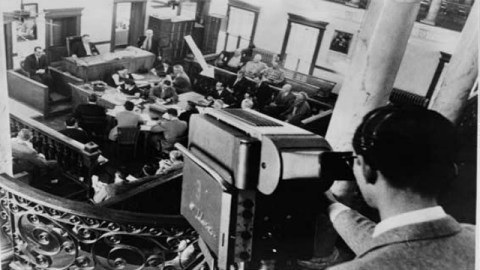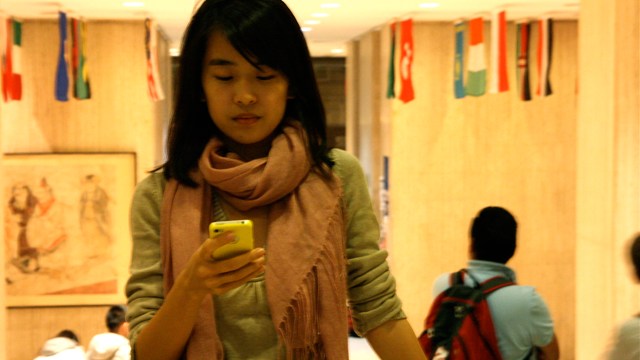Cameras in Court: Justice’s Gain

Law Think examines timely and timeless legal and human rights issues facing the UK and the world.
Lord Hewart CJ once stated, “…justice should not only be done, but should manifestly and undoubtedly be seen to be done.” These enduring words have taken on a new dimension in the debate as to whether cameras, particularly video cameras, should be allowed in courts. Indeed, a modern day reinterpretation of Lord Hewart CJ’s dictum might read: “…justice should not only be done, but should…be seen to be done”…on television. After all, the common law is an evolutionary beast and there are compelling reasons to suggest that allowing cameras in court would be justice’s gain.
First, allowing cameras in court would stymie inaccurate reporting of judgments that has recently overwhelmed the print media and even politicians. One only has to look back a few weeks to find the Home Secretary blaming the Human Rights Act for preventing the deportation of an illegal immigrant on the grounds that he would be split up with his cat. Similarly, the print media rounded on the Human Rights Act for preventing the deportation of Learco Chindamo, the killer of Philip Lawrence, following the decision of an Immigration Tribunal. On reading these judgments it is obvious that the cat and the Human Rights Act, respectively, were insignificant to the ultimate decisions. Unfortunately, very few people did read the judgments and, instead, took the Home Secretary’s and print media’s comments as given.
Cameras in court could only possibly stem the flow of this trend by providing a medium through which ordinary people could easily check the veracity of what is being fed to them. After all, it is much harder to edit a televised judgment for your own ends than it is to misquote a judgment. Ultimately, this would encourage the print media and politicians to report judgments more accurately for fear of being shown up.
The second argument in favour of cameras in court centres on the notion of “open justice”. We prize open justice because it serves the rule of law which demands that there is public confidence in legal institutions. In Sussex Justices, Lord Hewart CJ was actually saying that public perception of fairness is just as important as fair decision-making itself. For example, if the public could have watched as judgments were delivered and reasons given to those convicted of rioting, they could have better understood why certain lenient or harsh sentences were being handed out. Therefore, by making the inner workings of trials much more accessible than at present, cameras in courtrooms would appear to enhance the impression of fairness and, thereby, public confidence in the legal system. This would appear to be all the more important following the recent public outcry over court secrecy regarding superinjunctions.
Nevertheless, open justice is subservient to the overall “administration of justice” and can occasionally frustrate that greater aim. This is most apparent in applications for freezing injunctions and search orders which are often made to the court without the other party’s knowledge. The point here is that whilst open justice should be the default rule, exceptions can be admitted where the overall administration of justice would be defeated. However, it is for those attempting to carve out the exceptions, in this case whether cameras should be allowed in court, to persuade us that justice would not be served.
This inexorably gives rise to the first counter-argument that, in criminal cases, witnesses may be afraid to have their face on television and defendants may be disproportionately victimised on acquittal or at the end of their sentence. This fails to recognise the flexibility of open justice. Judges could be granted the discretion to restrict filming to certain parts of the trial, for example legal argument and the judgment. In other words, the argument that witnesses and defendants should never be televised does not mean that cameras in court would, in and of itself, be justice’s loss.
A second argument often levelled against cameras in court is that the media would sensationalise Counsel’s arguments and judges’ decisions or that lawyers and judges might themselves grandstand. Experience, however, suggests otherwise. The Supreme Court has been televised since May 2011, receiving on average 90,000 visitors a day, and none of these concerns have materialised. In fact, the footage has been more notable for the number of people falling asleep in the rows behind Counsel than for anyone playing to the cameras.
Finally, a third argument made against cameras in court is that it would foster disrespect for the courts and for the law. As John Godfrey Saxe stated in 1869, “Laws, like sausages, cease to inspire respect in proportion as we know how they are made.” In fact, some argue that politicians are held in lower esteem nowadays than they were in the 1980s before what happened in the House of Commons was laid bare for everyone to see.
It is very dangerous to accept this paternalistic argument. If we are somehow embarrassed to shine a light on how our laws are made or adjudicated upon, the solution is surely to refine those processes so that they inspire respect, rather than shrouding them in secrecy. Rather than subverting the administration of justice cameras in court may, therefore, act as a spur to much needed reform of outdated legal practices.
The legal system has a natural predisposition to status quo conservatism. Nonetheless, longstanding legal principles, particularly open justice, tend to suggest that cameras in court would be justice’s gain. Detractors lose sight of the fact that the issue of cameras in court is not all or nothing. Restrictions could quite easily be placed on the broadcasting of those parts of a civil or criminal trial if it would frustrate the administration of justice. Other counterarguments are simply misplaced or do not withstand scrutiny. It would be a fitting tribute, almost 90 years on from Lord Hewart CJ’s enduring dictum, to allow cameras in court. After all, what better way for justice to be seen to be done than at home on a large flat-screen television?





